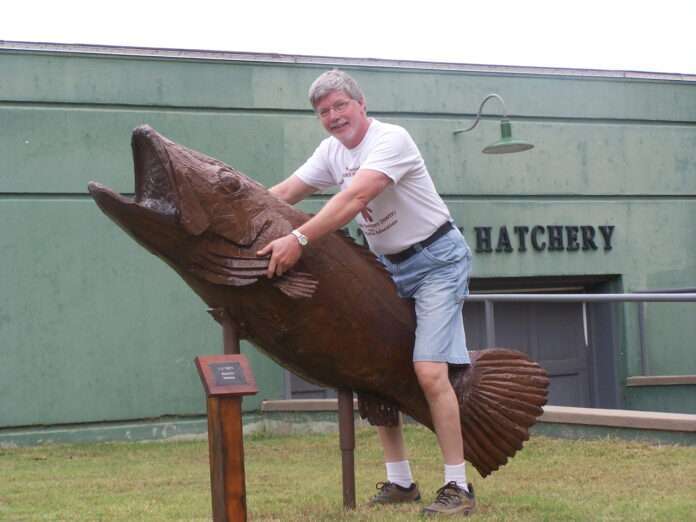I’ll never forget the look on Fritz Berger’s face as he spun around in the bow of the boat and exclaimed “Flathead; big flathead” with his hands spread wide apart to show us the length of the fish. The boat rocked wildly back-and-forth as he stabbed the long-handled dip net into a raft of floating debris trying to capture the big fish that had escaped his first attempt. “Got him,” he hollered as the net came up bulging with the beast. “Now I don’t know how to get him in the boat.”
After a time, Fritz was able to drag the fish around to the side of the boat to get around the tall railing that wrapped around the front and unceremoniously dump it into the tank in the middle of the boat. Welcome to electro-fishing, the method used by the Kansas Department of Wildlife, Parks and Tourism (KDWPT) to sample Kansas lakes, reservoirs and ponds to show them everything they need to know about fish populations in a given water impoundment, so they can better manage the fish populations therein. It helps them determine how many of what fish species are in the water, and shows them the condition of sport fish there. Today, a friend and I got to hang out with our District Fisheries Biologist Bryan Sowards and his summer intern Fritz Berger as they electro-shocked the small pond just east of Inman on property owned by the city of Inman affectionately known as “the city pasture.” The city has contracted with KDWPT to manage this pond for fishing.
Here’s how the electro fishing process works. A compartment near the center of the flat bottom aluminum boat houses a generator, and controls allow the operator to start and stop the unit plus adjust voltage and amperage. Two 36-inch diameter round steel wheels with numerous small metal rods dangling from them are lowered into the water and electrify a portion of water 6 to 8 feet deep and 6 to 8 feet in diameter around each wheel with 220 volts and 5 to 7 amps of electricity when the generator is started. These wheels hang from arms on each side of the bow of the boat, and can be adjusted for length and from side to side. The plan is usually to work around the edge of the lake or pond as near the bank as possible to capture fish that are lurking under the bank for protection. The fish are stunned long enough for “netters” working in the front of the boat to scoop them from the water and deposit them into a water tank for weighing and measuring.
The first challenge when electro-shocking a small pond like this became apparent immediately; there was no boat ramp. The boat trailer was driven to a spot with the most room to navigate and backed as near the water as possible. Equipment was loaded onto the boat, then after a fair tussle, the 4 of us managed to rock and shove the boat from the trailer onto the pond. We all piled aboard, Bryan at the controls, Fritz in the front manning the net and my friend and I off to the side, out of the way. The generator was started and Bryan steered the boat toward the nearest bank. The pond is odd-shaped with overhanging trees and lots of floating debris around its edge, so the next challenge became getting the hanging wheels dispensing the electricity close enough to the bank to do their job without tearing everything up. Fish of all species and sizes began floating to the surface where Fritz netted them and dumped them into the tank. Some shallow little coves littered with downed limbs and trash took a couple tries to properly sample. After making a loop completely around the pond, Bryan ran the boat ashore and we stopped to count and weigh the collection.
There were a couple nice largemouth bass of 2 to 3 pounds, several smaller largemouths, a couple small channel catfish, a few smaller crappies, both black and white, some rough fish like carp and buffalo that were immediately removed and the big flathead that was around 30 inches long and probably weighed 25 pounds. Also seen were numerous shad, the main baitfish found in our large Kansas lakes and reservoirs, and Bryan had no answer for how they came to be there.
The boat was much easier to load back onto the trailer that it was to get into the pond, and they were on there way. Sowards was amazed at the diversity of fish found in that small pond, but was not impressed with the mix of fish present when looking at things from the viewpoint of managing it for fishing. He will put together a report to present to the city with recommendations on how best to proceed. Our KDWPT wildlife and fisheries biologists and conservation officers do a crack job of managing God’s creation here in Kansas as far as I’m concerned. The next time you see one of them out-and-about, give them a “Thank You” for helping you be able to Continue to Explore Kansas Outdoors.
Steve can be contacted by email at stevenrgilliland@gmail.com.




